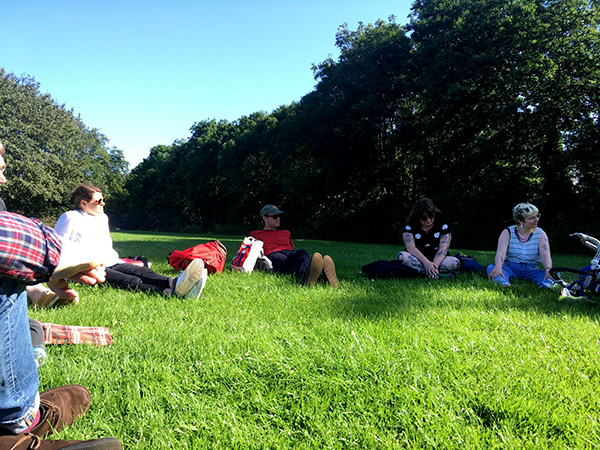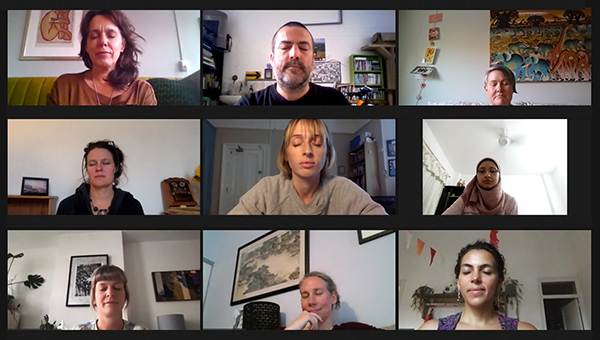--------------------------------------------------------
WHERE WE FIND OURSELVES
walking, deep listening, generative practice
2022
--------------------------------------------------------
The first iteration of this work took place at New Bridge Project, Newcastle in summer 2021.
The second phase took place as part of a year long 'artist-in-resonance' role with Dancing on the Edge, a festival of movement based in Amsterdam. Participants were invited into a year-long co-enquiry into deep listening as a transformative collective practice, using the guiding principle of ‘starting from where we find ourselves’. This experiment was continued due to demand and is set to end in July 2024, after over two years.
A third iteration of the project was commissioned by Festival Of Debate, Sheffield in May 2024.
The phrase 'where we find ourselves' emerges from writer, thinker and co-founder of Dark Mountain and A School Called Home, Dougald Hine’s response to a pilgrimage I completed in 2022 (see The Book Of Visions project), describing it as ‘an act of weaving, stitching together the torn fabric, starting from where we find ourselves.’ The phrase calls us into dialogue with our surroundings and each other. It calls us to notice with whom or what we share space and time, to behold our relationships with tangible and intangible worlds, to act out of a sense of kinship. It calls us to hold space not just for positive futures and collective yearning, but also for the grief and trauma of our entangled realities, and for that which does not make sense right now.
Co-listening is an exploratory collective practice that focuses on transformative listening by freeing participants from the need to respond, a key principle of which is to listen for understanding rather than agreement. I kept an irregular journal of the practice as it developed. Here is an extract:
19.10.22
We listen to each other speaking and we listen to each other refrain from speaking. We listen together to sounds from our individual environments that punctuate our shared silence: children playing in Amsterdam, birds in a tree in Alexandria, a coffee being delivered to a cafe table in Palermo, the dusk falling in Paris, a laptop overheating in Sheffield. We listen to the silences that we build together, which have something of a healing quality for the knowing that we have built them together.
We have now been developing this practice together for six months, with new and now familiar faces arriving each time, and what I have been most struck by as the sessions have progressed, is how each time is so markedly different. The rhythm and feel of each session is distinct, held by the growing experience within the group, and also invigorated by those experiencing it for the first time.
I have been learning from the writing and thinking Pauline Oliveros, the founder of the deep listening movement, and noticed something that Pauline’s life partner Ione mentioned in her recollections about her experience of facilitating Pauline’s ‘Tuning meditation’, from her well-known work Sonic Meditations (1971). The instruction for the meditation is:
“Inhale deeply; exhale on the note of your choice; listen to the sounds around you, and match your next note to one of them; on your next breath make a note no one else is making; repeat. Call it listening out loud.”
Recalling facilitating this work with audiences, Ione recalls how, in the exercise of ‘listening to our listening’, as she describes it, ‘something special, something both old and new, occurred. Something healing’. Pauline herself once spoke about how practiced listening continues to evolve, consistently yielding new information, and there is something of this beginning to emerge out of our sessions.
One recent session began to feel like a magical séance, as multiple synchronicities curiously wove themselves through the fabric of our shared space, so that all we could do was to laugh together. The last session took place over dusk for many of the localities on the call, and as our windows darkened, we listened to each other speak in shared and native languages. For some this meant casting words into the void, not knowing if they were being understood, and for others it meant listening beyond language to what else is held in the voice.
We continue with our experiment.
The complete journal can be found in Dancing On The Edge's online magazine . An article based on these journals will be published in late 2024.

